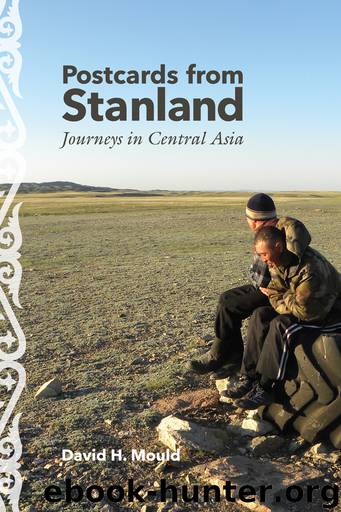Postcards from Stanland by David H. Mould

Author:David H. Mould [Mould, David H.]
Language: eng
Format: epub
Publisher: Ohio University Press
Published: 2016-04-22T04:00:00+00:00
seven
Father of Apples
Welcome to Almaty?
For travelers in the mid-1990s, Almaty airport was not a welcoming port of entry. Flights from Europe arrived in the wee hours of the morning, and passengers trudged bleary-eyed through a seemingly endless series of document inspections. At one counter, my customs declaration was scrutinized and stamped; at the second, the stamp was inspected and initialed; at the third, an official tore off part of the form; finally, another reattached it. The process was observed by uniformed police and unsavory looking characters in leather jackets, whose scowling faces made you think you were doing something illegal, even if you weren’t. Kazakhstan wasn’t thinking about customer service rankings on global tourism surveys.
On my first visit in 1995, the US embassy in Bishkek sent a driver to pick me up. We drove into Almaty on an almost deserted highway, the darkness broken only by an occasional light from a house. Even in the downtown area, few lights were on. At 2:30 a.m., I checked into the Hotel Almaty and quickly fell asleep, my six-foot frame wedged sideways on the five-and-a-half-foot bed.
I was awakened around 8 a.m. as morning sun filled the room. In my late-night stupor, I had forgotten to close the drapes. I stepped out onto the balcony and literally gasped. Before me was a mountain panorama unlike any I had ever seen before. The winter sun illuminated the rugged snow-covered peaks of the Zailiysky Ala Too. I almost forgot about the grim airport and undersized bed and pinched myself to make sure I wasn’t dreaming. No, I was not. I was in Central Asia.
I didn’t see much of Almaty on that trip. It was not until 1999, when I was doing media research for USAID, that I spent more than a couple of days in the city. Although Astana had become the capital two years earlier, there was no sense that Almaty faced an uncertain future. It was the largest city in the country and its commercial hub, with headquarters for domestic and foreign companies, universities, hospitals, and a lively music and arts scene. New hotels, restaurants, shops, and supermarkets were opening, and a growing middle class was flaunting its wealth, building houses in the new suburbs toward the mountains and driving imported cars. Since 1999, I’ve been to Almaty half a dozen times, for periods from a week to a month, and have seen the city grow, its population increasing to close to two million.
Although some Soviet histories suggested that Almaty was not much more than a wide place in the road to Tashkent until the Russian army arrived in 1854, there’s evidence of prehistoric settlements in burial mounds from the Saka period (from 700 BCE). By the eleventh century, the settlements were part of the Silk Road network, trading agricultural produce and crafts. An area called Almatu was first mentioned in thirteenth-century books. Although academics don’t agree on the origins of the name, the most likely explanation (and the one accepted by many Almaty residents) is that it comes from alma, the Turkic (and later Kazakh) word for apple.
Download
This site does not store any files on its server. We only index and link to content provided by other sites. Please contact the content providers to delete copyright contents if any and email us, we'll remove relevant links or contents immediately.
Full Circle by Michael Palin(3268)
How to Read Water: Clues and Patterns from Puddles to the Sea (Natural Navigation) by Tristan Gooley(3239)
Into Thin Air by Jon Krakauer(3129)
How to Read Nature by Tristan Gooley(3077)
In Patagonia by Bruce Chatwin(2755)
The Lost Art of Reading Nature's Signs by Tristan Gooley(2545)
A Thousand Splendid Suns by Khaled Hosseini(2520)
Don't Sleep, There Are Snakes by Daniel L. Everett(2499)
City of Djinns: a year in Delhi by William Dalrymple(2435)
Venice by Jan Morris(2430)
The Songlines by Bruce Chatwin(2413)
L'Appart by David Lebovitz(2393)
The Big Twitch by Sean Dooley(2318)
The Queen of Nothing by Holly Black(2315)
Tokyo Geek's Guide: Manga, Anime, Gaming, Cosplay, Toys, Idols & More - The Ultimate Guide to Japan's Otaku Culture by Simone Gianni(2239)
A TIME OF GIFTS by Patrick Leigh Fermor(2101)
Iranian Rappers And Persian Porn by Maslin Jamie(2095)
INTO THE WILD by Jon Krakauer(2085)
Come, Tell Me How You Live by Mallowan Agatha Christie(2025)
